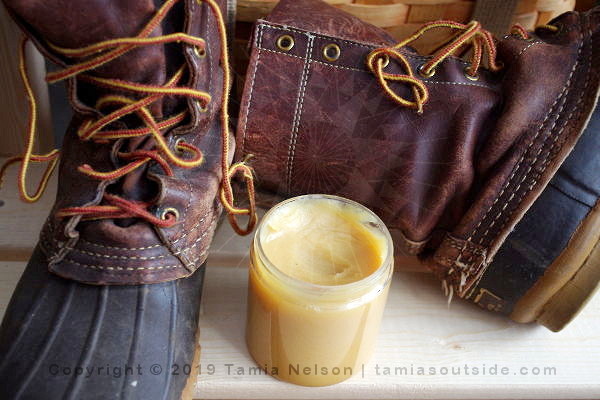You waxed your car. You painted the deck. You brushed the dog. But when did you last Sno-Seal your boots?
______________________________
by Tamia Nelson | February 11, 2019
Originally published in different form on November 11, 2012
I like leather boots. And when I find a pair that fits, I want to keep it going as long as possible. Farwell has some work boots that have been resoled five (or is it six?) times. But they’re old-style boots, made back in the day, when every small city boasted at least one cobbler and it was no big deal to get a pair of boots resoled. Those days are long gone, of course. Ours is now a use-it-once-and-toss-it-away economy. True, most modern hiking boots are good for more than a single outing. But just try getting a worn pair resoled…
Still, there are a few things you can do to get the most out of your investment in footwear. You can treat the leather with a preservative from time to time, for instance. I use Atsko Sno-Seal. It claims to be the “original beeswax waterproofing,” and for all I know, it is. That’s not why I use it, though. I use it because it works. It keeps my boots supple without making them soft, and it also does a pretty good job of keeping water on the right side of the leather and out of my socks. (Will Sno-Seal transform your leather hiking boots into wellies? No way. But it will help you keep your feet dry on wet trails.)
Sno-Seal has the appearance and consistency of peanut butter—a rather soft, etiolated peanut butter. (It doesn’t smell anything like peanut butter, though. And I don’t think I’ll ever be tempted to put it on a bagel.) The Sno-Seal of my youth was made of sterner stuff. It often had to be heated just to make it daubable. Try this with modern Sno-Seal, however, and the goop only gets runny. Not that I’m complaining, you understand. Convenience trumps ritual (almost) every time. Today’s Sno-Seal is ready for use as is, right off the shelf and out of the jar, and that’s a very good thing.
Which isn’t to say that Sno-Sealing boots doesn’t involve a bit of ritual. And what follows is the Order of Service.
- Brush off any clinging dirt.
- Remove laces.
- Warm boots. Don’t cook them! They should be pleasantly warm to the touch. Just that and no more.
- Spread Sno-Seal onto the leather, rub it in, giving seams and scuffed areas a little extra.
- Let the Sno-Seal soak in. Treat any remaining dry spots. And wipe off any blobby excess.
- Lace up.
Now I’ll elaborate:
1. Brush all the soil off your boots. (This is easier to do if you let the mud dry, first.) Unless you’re a member in good standing of the Price Is No Object Club, you’ll be hard-pressed to find boots made from a single piece of cowhide at a price you can afford. No matter. The pieced-together uppers on my boots should last as long as the soles, and that’s the most I can hope for. But each and every seam will need special attention when Sno-Sealing and so will these badly scuffed toes.
2. Next, remove the laces.
3. Put your boots someplace warm. I set mine down on a patch of sun-warmed gravel, right up against a south-facing wall. Fifteen minutes in this sun trap did the trick, even though the day was chilly. The leather was warm to the touch.
4. Sno-Seal is tenacious stuff. It’s not easy to wash off, and while that’s a good thing in a dubbin, I didn’t fancy Sno-Seal as a garnish with my dinner. So, protect your bare hands by wearing waterproof gloves or by using a wad of clean cotton rag. Scoop a teaspoon-sized blob of Sno-Seal from the jar and rub it onto the boot uppers, including the little leather tags on the boot’s tongue and collar. I also gave the all-too-numerous seams special attention. When I finished with one boot, I put it back in its place in the sun and immediately turned my attention to its mate. The job takes only a few minutes.
5. After the second boot has a chance to soak up some more sun—and the Sno-Seal a chance to soak into the leather’s pores—subject both boots to a close inspection, searching for places that still seem a bit dry. Find any? Then treat them to a second dressing of Sno-Seal. I usually use a little too much Sno-Seal on the first go-round, which means I have to wipe the excess off with a cloth.
6. Lace up the boots and tuck them back on the boot rack.
Final Notes Sno-Seal is pretty innocuous stuff. Work outside if you like, or indoors, but on pleasant days I take full advantage of the warm sun and cloudless sky.
How about it? Could your leather boots use a little TLC? If it’s been a while since you last treated them to a dab or two of Sno-Seal (or whatever leather dressing you prefer), they probably could.


